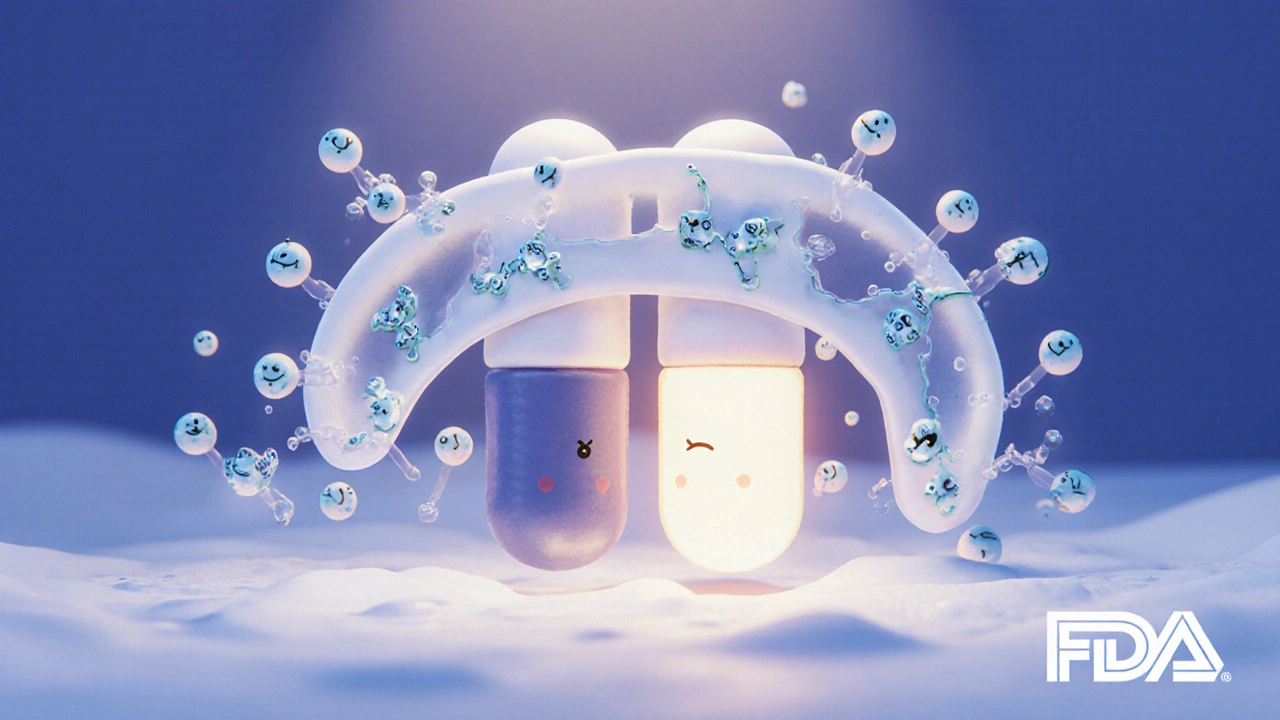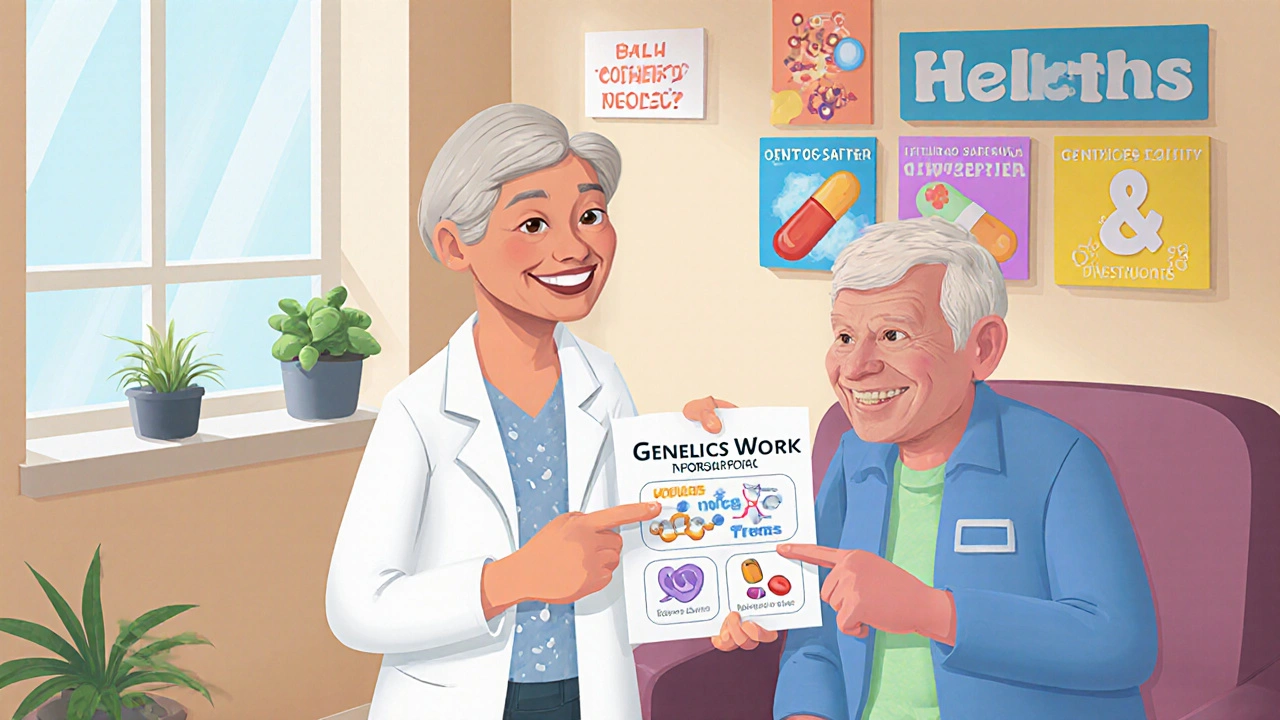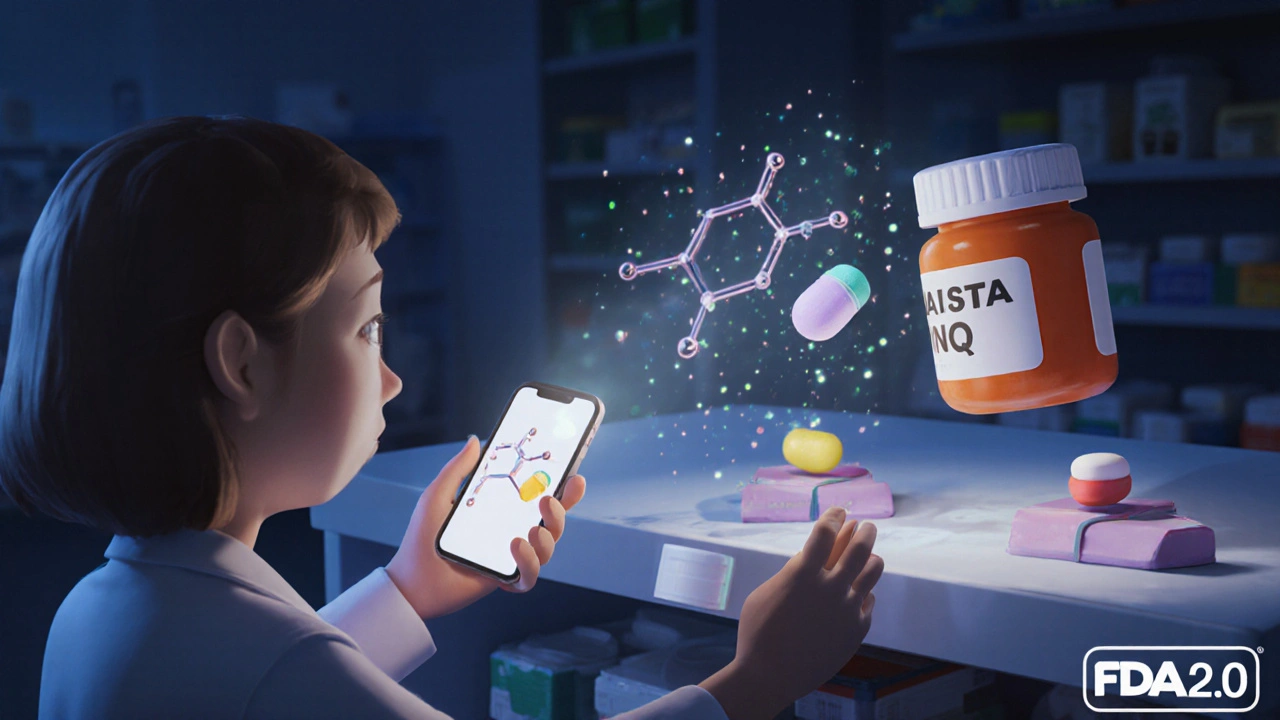Infographics About Generics: Visual Education Tools That Build Patient Trust

More than 9 out of 10 prescriptions filled in the U.S. are for generic drugs. Yet, many patients still hesitate to take them. Why? Because they look different. They cost less. And somewhere along the line, they were told - maybe by a well-meaning friend, a TV ad, or even a vague comment from a provider - that "generic" means "lesser."
That’s where infographics come in.
These aren’t just pretty pictures. They’re precision tools. Designed by scientists, tested with real patients, and backed by decades of regulatory data, generic drug infographics turn confusing science into clear visuals. They answer the quiet, anxious questions patients don’t always say out loud: "Is this really the same?", "Will it work?", "Am I being cheated?"
What Makes a Generic Drug the Same?
The biggest myth? That generics are "copies" or "imitations." They’re not. A generic drug must meet the exact same standards as its brand-name counterpart - down to the active ingredient, strength, dosage form, and how it’s absorbed by the body.
The FDA doesn’t just approve generics based on paperwork. They require bioequivalence studies. That means the generic must deliver the same amount of medicine into the bloodstream at the same rate as the brand. Not close. Not "mostly." The same.
One of the most powerful visuals in the FDA’s "What Makes a Generic the Same as a Brand-Name Drug?" infographic shows side-by-side dissolution curves. These graphs track how quickly the drug breaks down in simulated stomach fluid. If the lines overlap, the drugs behave the same way. In FDA testing, 89% of patients understood this visual. Only 67% got it from non-FDA versions.
It’s not magic. It’s chemistry. And the infographic makes that chemistry visible.
Why Patients Still Doubt - And How Infographics Fix It
Even with all the data, 43% of patients still worry generics won’t work as well. That’s not ignorance. It’s experience.
Patients see the difference. The shape. The color. The pill imprint. One person told a pharmacist, "This one’s smaller. It’s not the same." Another said, "I used to take the blue pill. Now it’s white. I don’t trust it."
Infographics tackle this head-on. They show side-by-side photos of brand and generic versions. Then they explain: "The difference is in the inactive ingredients - the fillers, dyes, binders. These don’t affect how the medicine works. They only change how the pill looks or tastes."
One study found that when pharmacists showed patients the FDA’s infographic during counseling, patient refusals of generic substitutions dropped by 63%. In one clinic in Ohio, pharmacists kept printed copies behind the counter. One said, "I’ve cut my counseling time in half. Patients just point to the picture and say, ‘Oh, okay.’"
Who Makes These Tools - And What Sets Them Apart
The U.S. Food and Drug Administration (FDA) leads the pack. Their generic drug infographics are free, downloadable, and available in Spanish. They’re built for print and screen. All use high-contrast colors, alt text for screen readers, and language tested at an 8th-grade reading level.
The GTMRx Institute also creates strong visuals - but their focus is broader. They show how generics fit into overall medication management. Their newer digital versions let users input their own meds and get a personalized risk assessment. But they don’t offer the same breadth of language support. Only 30% of their materials are in Spanish.
BeMedWise has great patient-friendly tools, but they only cover generics in 3 out of 15 infographics. The FDA’s suite includes 8 core visuals, each targeting a different concern: cost, safety, manufacturing, exclusivity, and even health equity.
And that last one matters.
Black and Hispanic patients report higher concerns about generic quality than white patients. The FDA’s "Generic Drugs and Health Equity Handout" is the only one that directly addresses this. It shows how generics lower out-of-pocket costs - a major barrier for low-income families. That’s not just education. That’s justice.

What’s Missing - And Why It Matters
Not all infographics are perfect.
Experts like Dr. Aaron Kesselheim from Harvard point out a real gap: narrow therapeutic index drugs. These are medications where tiny differences in blood levels can cause serious problems - like warfarin (a blood thinner) or levothyroxine (for thyroid disease). The current visuals say "same as brand," but they don’t show why pharmacists must be extra careful here.
The Institute for Safe Medication Practices says these tools should include a clear visual cue - maybe a red flag icon - when a generic substitution requires pharmacist notification. Right now, that’s only written in small text. Patients miss it.
Another issue? The dissolution graphs. They’re scientifically accurate, but 29% of patients on patient forums said they still felt "too complex." Some need simpler icons: a heart for cardiovascular drugs, a brain for antidepressants, a scale for weight-related meds.
And while the FDA’s materials are well-documented, only 40% cite the original studies behind the claims. Patients who want to dig deeper don’t know where to look.
How Clinics and Pharmacies Use Them
You won’t find these infographics in fancy apps. You’ll find them in waiting rooms. On reception desks. Printed on cardstock. Linked in patient portals. Shared in text messages.
Kaiser Permanente in Southern California trains staff to use them during check-in. Pharmacists keep them behind the counter. One clinic in Texas started handing them out with every new generic prescription. Within six months, generic acceptance rose 22%.
Even big tech is on board. Epic Systems, the electronic health record giant, added FDA infographics to its patient education module in late 2022. In six months, over 450,000 patients viewed them.
They’re not meant to replace conversation. They’re meant to make it easier. A patient walks in worried. The pharmacist says, "Let me show you something." Five minutes later, the patient nods. "Oh. So it’s really the same."

The Bigger Picture - Cost, Access, and the Future
Generic drugs saved the U.S. healthcare system $1.68 trillion between 2010 and 2019. That’s not just a number. That’s a cancer patient who can afford their chemo. A diabetic who doesn’t skip doses because the pill is too expensive. A senior on fixed income who keeps their blood pressure under control.
And it’s getting bigger. In 2023, generics saved $313 billion in a single year - up from $297 billion in 2021. The FDA’s new 2.0 infographic reflects that.
By 2028, experts predict generic use could hit 95%. That’s possible - if patients trust them.
The next wave? Augmented reality. The FDA showed a prototype at their 2023 Digital Health Summit. Point your phone at a pill bottle. A 3D model pops up. You see the active ingredient in the brand version. Then you see the exact same molecule in the generic. Side by side. Identical.
It’s not science fiction. It’s coming.
Where to Find These Tools
You don’t need to search far.
The FDA’s entire generic drug infographic library is free at fda.gov/generics. All files are downloadable PDFs. Print them. Email them. Share them. No login. No cost.
GTMRx Institute resources are at gtmrx.org. Their interactive tools require a web browser, but they’re powerful for complex regimens.
For clinics: Use the FDA’s Stakeholder Toolkit. It includes sample social media posts, printable cards, and a 15-minute training video for staff. Over 12,000 healthcare workers have already taken it.
And if you’re a patient? Print one. Keep it in your medicine cabinet. Bring it to your next appointment. Show your doctor. Ask, "Is this the same?" Then show them the picture.
Are generic drugs really as safe as brand-name drugs?
Yes. The FDA requires generic drugs to have the same active ingredient, strength, dosage form, and bioequivalence as the brand-name version. They’re held to the same manufacturing standards and inspected in the same facilities. Over 90% of prescriptions filled in the U.S. are generics - and they’ve been used safely by millions for decades.
Why do generic pills look different from brand-name ones?
The difference is in inactive ingredients - things like dyes, fillers, and coatings. These affect the pill’s color, shape, or taste, but not how it works. The active ingredient - the part that treats your condition - is identical. Federal law requires generics to look different so they aren’t mistaken for the brand.
Can I trust generics if they cost so much less?
Absolutely. Generics cost less because manufacturers don’t have to repeat expensive clinical trials. The original brand company already proved the drug is safe and effective. Generic makers only need to prove their version works the same way. That’s why they’re cheaper - not because they’re lower quality.
Do generics work the same for all conditions?
For most drugs - yes. But for a small group called narrow therapeutic index drugs (like warfarin, levothyroxine, or phenytoin), even tiny differences in absorption can matter. In these cases, pharmacists are trained to notify you before switching. The FDA’s infographics don’t yet show this clearly, so always ask your pharmacist if your drug is one of these.
Where can I get these infographics for my clinic or pharmacy?
All FDA generic drug infographics are free to download at fda.gov/generics. You can print them, email them, or link to them from your website. The FDA also offers a free Stakeholder Toolkit with ready-to-use materials for healthcare providers.
Are these infographics available in languages other than English?
Yes. The FDA offers all its generic drug infographics in Spanish under the title "Medicamentos Genéricos." Other organizations like GTMRx offer fewer translated versions. If you serve non-English-speaking patients, the FDA’s Spanish materials are the most complete and reliable resource.
Can I use these infographics with my elderly or low-literacy patients?
Yes. The FDA designs its infographics for an 8th-grade reading level and uses high-contrast colors and simple icons. They’re tested with real patients, including older adults and those with limited health literacy. Many clinics use them with success in senior centers, community health centers, and home visits.
Do these infographics work for mental health medications?
Yes. Many patients on antidepressants, antipsychotics, or mood stabilizers worry about switching to generics. The FDA’s visuals help explain that the active ingredient remains unchanged. While some patients report feeling different after switching, studies show this is often due to placebo effect or other factors - not the drug itself. The infographic helps separate myth from science.

Sarbjit Singh
November 19, 2025 AT 13:39Angela J
November 21, 2025 AT 08:09Emily Entwistle
November 21, 2025 AT 16:32Duncan Prowel
November 23, 2025 AT 15:47Bruce Bain
November 23, 2025 AT 21:10Jonathan Gabriel
November 25, 2025 AT 08:09Don Angel
November 25, 2025 AT 21:01benedict nwokedi
November 27, 2025 AT 03:56deepak kumar
November 28, 2025 AT 07:02